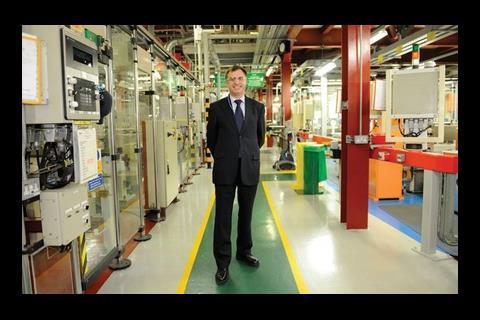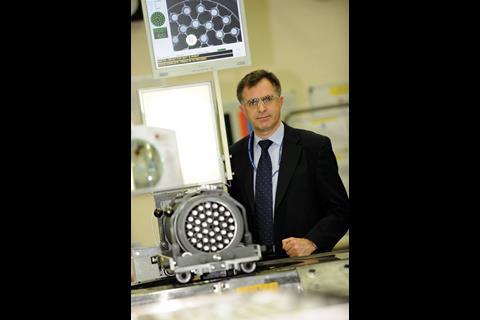Japanese-owned nuclear giant Westinghouse is in a race with FranceŌĆÖs Areva for the UKŌĆÖs ┬Ż20bn nuclear reactor market. And it looks like itŌĆÖs falling behind. We asked the man spearheading the bid if he was worried...
By rights, Mike Tynan should glow in the dark. The new chief executive of Westinghouse UK has been in the nuclear industry since 1975, during which time he has been responsible for waste treatment at Sellafield and headed Springfields Fuels, the division of Westinghouse that supplies the uranium used by all but one of the UKŌĆÖs reactors.
Now, this quiet man of the nuclear industry is emerging from the shadows to spearhead WestinghouseŌĆÖs drive to capture the ┬Ż20bn-plus nuclear new-build market with its AP1000 reactor.
Tynan doesnŌĆÖt appear fazed by this challenge ŌĆō indeed, he has big ambitions. ŌĆ£We would like eight AP1000 reactors in the UK. We would be absolutely thrilled to have one on the grid by 2017,ŌĆØ he says. ŌĆ£My personal objective is to ensure that the first new nuclear reactor on the grid is the AP1000.ŌĆØ
Tynan has got his work cut out. Although Westinghouse is one of only two companies undergoing the generic design assessment process that will entitle it to sell reactor designs in the UK, its rival, Areva, is one step ahead. Its European pressurised water reactor (EPWR) is already under construction in Finland and France and it has teamed up with energy firm EDF to build four reactors on two sites in the UK (subject to licences being granted). It has already got Balfour Beatty on board and has formed a joint venture with Vinci Construction.
ŌĆ£Areva is in a slightly better position at the moment because of the arrangement with EDF,ŌĆØ Tynan admits. ŌĆ£WeŌĆÖre not at that stage yet.ŌĆØ Although this may be of some concern to Westinghouse, it may be good news for the construction industry, as the job of building the AP1000 is up for grabs, and Westinghouse says it will procure everything locally.
Given that EDF owns seven nuclear sites in the UK, where does that leave Westinghouse? EDF has agreed to sell land at three sites, including Wylfa in Wales and Bradwell in Essex. The Nuclear Decommissioning Authority is also putting forward sites for reactors, including Oldbury in Gloucestershire and Sellafield in Cumbria. Once the government has signed off the nominated sites, these will be auctioned to utilities companies at the end of March. ŌĆ£ItŌĆÖs been likened to an eBay sale,ŌĆØ says Tynan.
Those in the running to take the sites, and TynanŌĆÖs reactor, include Scottish and Southern Energy, in partnership with Spanish utility firm Iberdrola and Belgian company GDF Suez; Swedish firm Vattenfall; and a joint venture between German companies E.ON and RWE. His target sites are Wylfa, Bradwell, Sellafield and Oldbury.
Why would these customers buy the AP1000 rather than the EPWR? Well, the standard sell is that the AP1000 is the most modern, safest and technologically advanced reactor in the world. And there are key differences between the two reactors: Tynan reckons the 1,000MW-output AP1000 is more suitable for the UK grid than its 1,600MW competitor, because of the lack of grid capacity at most of the sites. He adds that EDF favours Sizewell in Suffolk and Hinckley Point in Somerset because they do have capacity.
Another notable distinction between the reactors is that the AP1000 is modular. This gives utilities more procurement options as it can simply be delivered to site as a kit of parts. ŌĆ£If you think of it as an Airfix kit, the reactor vendor can deliver the parts and instructions to the preferred site and you get some people to put it together,ŌĆØ says Tynan.
There is a challenge being put down to the UK industry: can you deliver to the required standards?
Mike Tynan
In reality, Westinghouse will offer utilities firms pretty much any procurement option they want, including the risky turnkey package being used to deliver the EPWR in Finland. ŌĆ£If it wanted us to put it together we would ŌĆō full risk sits with the vendor under the engineer, procure, construct model,ŌĆØ says Tynan. If the utilities firm wants to procure a reactor under a construction management contract, Westinghouse would do that, too.
Tynan sees getting the procurement model as the key to ensuring the reactor is delivered on time and to budget. ŌĆ£The commercial model between the utilities firm and reactor vendor is vitally important to ensure you come in within cost and schedule,ŌĆØ he says. ŌĆ£The key to getting it right is building a relationship from the very early stages.ŌĆØ
We already know what can happen if this is not nailed down. The Finnish scheme is three years late and 50% over budget and the reactor in France is also facing problems with concrete and welding quality. Tynan thinks the success or otherwise of the project is down to a number of factors, including the choice of contractor, the quality of the vendorŌĆÖs specification and the relationship between the utilities firm and the reactor supplier.
Because Westinghouse has not signed any deals yet, it has not started to talk in earnest to contractors. ŌĆ£WeŌĆÖre not yet contracted to a firm to deliver a design,ŌĆØ says Tynan. ŌĆ£ItŌĆÖs a chicken and egg situation ŌĆō how far can you speculate about getting a supply chain before you have a unit contracted?ŌĆØ
Tynan says he has talked to ŌĆ£one or two contractors in a broad senseŌĆØ, although he declines to give names. Again he is at pains to emphasise the procurement route ŌĆō if the utilities firm decides to build the reactor itself then the choice of contractors will be out of WestinghouseŌĆÖs hands.
Whatever the route adopted, Westinghouse needs a UK supply chain for reactor components. So far it has memorandums of understanding with BAE Systems, Doosan Babcock and Rolls-Royce. Sheffield Forgemasters is contracted to supply the reactor pressure vessel. Rolls-Royce is providing technical expertise and advising on the generic licensing process, BAE will assemble modules and Doosan Babcock will supply components.
Does Tynan worry that UK components will not be up to the job, given that there have been problems with pressure vessel welding in France and Finland? Not a bit of it. ŌĆ£Sheffield Forgemasters is as good as, if not better than, anyone else in the world.ŌĆØ
Despite this endorsement, Tynan warns that companies must reach the right quality and safety standards if they want to be involved. ŌĆ£There is a challenge being put down to the UK industry: can you deliver to the required standards?ŌĆØ
Tynan says things need to start moving once the sites have been auctioned off later this year. ŌĆ£This year is going to be critical if they want to get reactors on the grid by 2017 or 2018,ŌĆØ he says. People will need to sign up to programmes by the end of the year and be turning earth by 2012 or 2013 at the outside.ŌĆØ By then we may know whether TynanŌĆÖs dream of putting the first new reactor on the UK grid is going to become a reality.
Postscript
Original print headline: Power struggle: The race to build Britain's reactors






























No comments yet